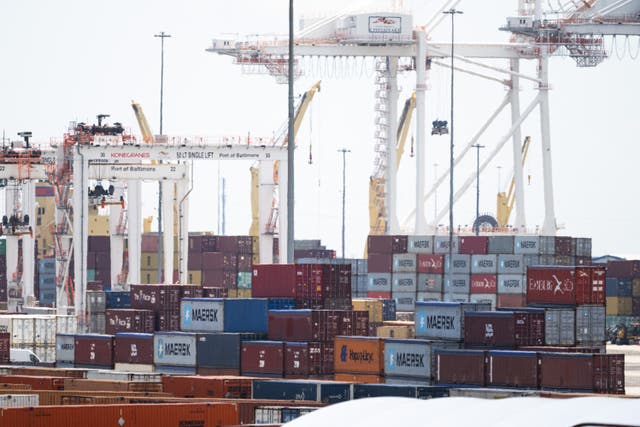How Canada And Mexico Can Boost Trade Despite US Tariffs

Table of Contents
Diversifying Trade Relationships Beyond the US Market
Reducing over-reliance on the US market is crucial for bolstering Canada-Mexico trade. Proactive diversification into new markets offers greater economic resilience and mitigates the impact of future trade uncertainties.
Exploring New Markets
Focus on expanding exports to new and emerging markets is paramount. This involves a multi-pronged approach:
- Asia: Aggressive pursuit of trade deals and increased export efforts to China, Japan, South Korea, and other key Asian markets. This requires targeted market research to identify high-demand products in these regions.
- European Union: Leveraging existing trade agreements and exploring opportunities to expand market access for Canadian and Mexican goods and services within the EU.
- Latin America: Strengthening trade ties with Latin American nations through bilateral agreements and collaborative initiatives. This can unlock significant opportunities for increased trade in various sectors.
Developing targeted trade missions, investing in detailed market research, and identifying high-demand products are essential components of a successful diversification strategy. This proactive approach ensures that Canada and Mexico are not solely dependent on the volatile US market for their economic success.
Strengthening Regional Trade Agreements
Existing and potential regional trade agreements provide crucial frameworks for preferential trade access, further reducing dependence on the US.
- CPTPP (Comprehensive and Progressive Agreement for Trans-Pacific Partnership): Full utilization of the CPTPP's provisions to maximize trade opportunities with member countries, reducing reliance on North American trade.
- Strengthened Canada-Mexico Free Trade Agreement: Exploring the potential for a significantly enhanced bilateral agreement incorporating robust dispute resolution mechanisms and harmonized tariffs. This strengthens the Canada-Mexico trading relationship independently of the US.
By reinforcing these existing agreements and exploring new avenues for regional cooperation, Canada and Mexico can create a more robust and diversified trading landscape.
Enhancing Supply Chain Resilience and Integration
Building resilient and integrated supply chains within North America is vital for mitigating the negative impacts of external trade policies. This involves both regional cooperation and technological advancements.
Regional Value Chains
Promoting the development of integrated value chains within North America, specifically minimizing reliance on US-based intermediaries, is critical. This requires:
- Collaboration: Fostering increased collaboration between Canadian and Mexican businesses to create robust, regionally focused supply chains.
- Infrastructure Investment: Significant investment in infrastructure projects that improve cross-border transport and logistics, reducing transit times and costs. This includes improvements to roads, railways, and ports.
Creating these regional value chains ensures a more stable and less vulnerable supply chain, reducing the impact of external trade disputes.
Technological Advancements
Embracing technological advancements is essential for improving efficiency and resilience within the Canada-Mexico trade relationship.
- Digital Trade Infrastructure: Investing in robust digital trade infrastructure to streamline cross-border processes, reducing delays and improving transparency.
- Data Analytics: Implementing advanced data analytics to optimize supply chains, anticipate disruptions, and identify opportunities for improvement.
The adoption of these technologies can significantly improve efficiency, reduce costs, and enhance the overall resilience of the Canada-Mexico trade relationship.
Promoting Bilateral Cooperation and Investment
Strengthening bilateral cooperation and investment is fundamental to building a more robust and resilient Canada-Mexico trade relationship.
Joint Investment Projects
Increased cross-border investment is crucial for building economic ties and fostering mutual growth. This includes:
- Key Sectors: Focusing on joint ventures and collaborations in key sectors such as energy, manufacturing, and technology.
- Investment Incentives: Developing attractive investment incentives to encourage greater cross-border investment from both Canadian and Mexican companies.
This approach fosters economic integration, mitigating the impact of external trade pressures.
Harmonizing Regulations
Reducing trade friction requires a concerted effort to harmonize standards and regulations between Canada and Mexico. This involves:
- Regulatory Alignment: Working towards further harmonization of standards and regulations to reduce bureaucratic hurdles and simplify cross-border commerce.
- Customs Efficiency: Improving customs procedures and border efficiency to reduce delays and expedite the flow of goods.
Streamlining regulations and improving border efficiency significantly increases the flow of goods and services, enhancing economic integration between Canada and Mexico.
Conclusion
The imposition of US tariffs presents challenges to Canada-Mexico trade, but also offers a significant opportunity to create a stronger, more resilient bilateral relationship. By diversifying markets, enhancing supply chain integration, and fostering greater bilateral cooperation, Canada and Mexico can significantly boost their trade volumes and mitigate the negative consequences of protectionist policies. Investing in these strategies will not only strengthen the Canada-Mexico trade relationship but also contribute to the long-term economic prosperity of both nations. The future of Canada-Mexico trade depends on proactive engagement and strategic collaboration to overcome the current challenges and build a more robust and diversified economic partnership. Let's work together to strengthen Canada-Mexico trade and explore the potential of a vibrant, independent bilateral economic relationship.

Featured Posts
-
 Buy And Holds Gut Check A Realistic Look At Long Term Growth
May 25, 2025
Buy And Holds Gut Check A Realistic Look At Long Term Growth
May 25, 2025 -
 Discrepancies Revealed Ex French Pm And Macrons Policy Differences
May 25, 2025
Discrepancies Revealed Ex French Pm And Macrons Policy Differences
May 25, 2025 -
 Pre Owned Porsche 911 S T Riviera Blue Details And Specifications
May 25, 2025
Pre Owned Porsche 911 S T Riviera Blue Details And Specifications
May 25, 2025 -
 Florida Film Festival A Look At The Notable Guests Including Mia Farrow And Christina Ricci
May 25, 2025
Florida Film Festival A Look At The Notable Guests Including Mia Farrow And Christina Ricci
May 25, 2025 -
 F1 Testing Lewis Hamiltons Unexpected Gesture To Ex Team Mate Revealed
May 25, 2025
F1 Testing Lewis Hamiltons Unexpected Gesture To Ex Team Mate Revealed
May 25, 2025
Latest Posts
-
 Naomi Kempbell V Derzkoy Fotosessii Dlya Modnogo Zhurnala
May 25, 2025
Naomi Kempbell V Derzkoy Fotosessii Dlya Modnogo Zhurnala
May 25, 2025 -
 Elegantna Naomi Kempbell Noviy Obraz Na Zakhodi V Londoni
May 25, 2025
Elegantna Naomi Kempbell Noviy Obraz Na Zakhodi V Londoni
May 25, 2025 -
 Naomi Kempbell V Biliy Tunitsi Z Virizom Na Londonskomu Shou
May 25, 2025
Naomi Kempbell V Biliy Tunitsi Z Virizom Na Londonskomu Shou
May 25, 2025 -
 Novaya Fotosessiya Naomi Kempbell Smelye I Otkrovennye Snimki
May 25, 2025
Novaya Fotosessiya Naomi Kempbell Smelye I Otkrovennye Snimki
May 25, 2025 -
 Legendarna Naomi Kempbell 55 Rokiv Ta Naykraschi Momenti Kar Yeri
May 25, 2025
Legendarna Naomi Kempbell 55 Rokiv Ta Naykraschi Momenti Kar Yeri
May 25, 2025
